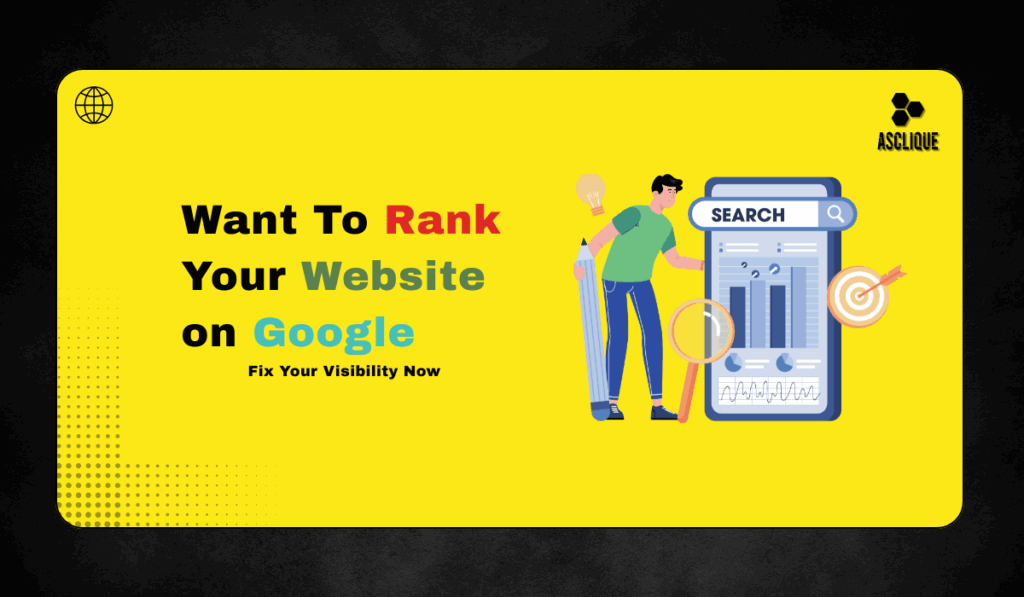How to get website visible on Google—it’s the first and most essential step after launching your business online.
What do you usually do when you’re looking for information on a product, a service, or a topic?
The likelihood is that you pick up your phone and Google it.
Everyone does it nowadays, which is why it’s vital that your website is discoverable in Google if your aim is to grow your business.
So, if you’re getting ready to begin a new business, one of the very first things you should do is acquire a website that can help provide that growth.
After you’ve got your website running, the next truly important thing you should do is get it appearing on Google.
In this detailed guide, we’ll walk you through what you have to do to get your website listed on Google and gain more customers.
Let’s begin!
Simple Ways to Make Your Website Show Up on Google
Once your website is live, your initial task must be learning how to get website visible on Google and other search engines. Below are the four main steps:
Add Your Site to Google
Before you submit your site, you can check whether it’s already indexed. Just type your_site.com into Google’s search bar.
Indexing simply means that your website has been added to Google’s database, making it discoverable.
You can get your site indexed in two ways:
- By submitting your sitemap to Google via Google Search Console
- By using Google’s ping service to notify them of your sitemap URL
Both options are completely free.
Although Google crawls and indexes sites on its own, this can sometimes take time. That’s why manually submitting your sitemap can speed up the process.
How to Locate Your Sitemap
To use the above methods, you’ll need your sitemap’s URL. The way you find or generate this depends on your site’s platform.
For instance, if your site is built on WordPress, plugins like Yoast SEO or Rank Math can automatically create sitemaps for you.
For other platforms or custom-built sites, try these common sitemap locations:
- yourwebsite.com/sitemap.xml
- yourwebsite.com/sitemap1.xml
- yourwebsite.com/sitemap_index.xml
If these URLs don’t work, check your website’s robots.txt file here: yourwebsite.com/robots.txt—your sitemap’s location is often listed there.
Method 1: Using Google Search Console
Here’s how to submit your sitemap via Google Search Console:
- Log in to your Search Console account
- Click on the Sitemaps option in the left-hand menu
- Enter your sitemap’s URL under Add a new sitemap
- Hit Submit
That’s it! Google will begin crawling and indexing your website.
Method 2: Google Ping Service
Google’s Ping Service allows you to prompt Google to crawl your updated sitemap. Simply paste this link into your browser:
http://www.google.com/ping?sitemap=<Your_Sitemap_URL>
Use this anytime you update your sitemap to speed up re-indexing.
Claim Your Business on Google
Creating a Google Business Profile (formerly Google My Business) is essential for local search optimization. This makes your business visible in Google Maps and local search.
Steps to Claim:
Step 1: Enter your business name, business type, and category.
Step 2: Input your accurate physical address. Google will send you a verification code.
Step 3: Mark the marker to the correct spot in Google Maps and confirm your business.
Enter your verification code into your Google Business listing to complete verification after receiving it.
Your business will appear when customers search for similar services in your area once it has been verified.
Tip: Never use Google Business if you lack a physical address.
Optimize Your Google Business Profile
Don’t stop at just registering. Fill in all business details—hours, services, contact info, etc. This makes it easier for potential customers to learn about you.
Keep this information current. If you change business hours, services, or contact numbers, update them promptly. Accurate info helps maintain trust.
Try To Get Reviews On Google Business
Invite your satisfied customers to write reviews with ratings. Reviews increase CTR (Click Through Rate) and visibility.
Engage with positive and negative reviews by all means. It shows that your company values customer feedback and builds confidence.
SEO Optimize Your Website
If your aim is to be ranked higher on Google search, do the following:
Make Your Website Mobile-Friendly: Responsive web design makes your website function smoothly on every device—smartphones, tablets, and desktops. The reason responsiveness is essential is that most of your users will be accessing your site via mobile.
Improve Website Loading Speed:
Page speed is a ranking factor in Google’s eyes. Here’s how to make your site load faster:
- Minimize HTTP requests
- Optimize images using plugins like TinyPNG, JPEG Optimizer, or ImageRecycle
- Choose a speed-focused hosting provider with CDN integration
Employ online resources like Google PageSpeed Insights to check your website’s speed
Keyword Optimization
Finding the best keywords is a very crucial part of SEO. If you can find low-competitive keywords or phrases that are relevant to your services and create quality content with those, it will be easier for your site to appear at the top of Google search results.
Selecting The Perfect Keywords
Use tools like:
- Ahrefs
- Semrush
- Keyword Surfer
- MozBar
Create Quality Content for Users
With keywords in hand, focus on creating content that serves your audience. Many site owners mistakenly write for search engines—don’t do that.
Google rewards websites that prioritize user experience over search engine manipulation.
So, make your content:
- Valuable and informative
- Well-written and original
- SEO-friendly (with proper headings, structure, etc.)
Keep your content fresh by regularly updating it, and aim to publish consistently.
And don’t forget to share your content across social media platforms to boost exposure and generate more traffic.
Have a Good Backlink Profile
Optimized content and keywords are not enough. Backlinks (links to your site from other sites) play a key role in driving visibility.
How to Get High-Quality Backlinks:
Outreach: Contact sites that are in your niche and ask them to link your content.
Guest Blogging: Write blog posts for good sites and include a link to your site.
Social Sharing: Post content on several networks like LinkedIn, Facebook, Instagram, and Twitter.
Internal Linking Strategy
Apart from backlinks, internal linking (referencing one page within your website to another) helps the search engines familiarize themselves with your site structure and give priority to indexing.
Utilize internal linking to highlight your most important content. This provides a clear content hierarchy and improves navigation for users as well as search engines.
Keep Your Website Fresh Regularly
Regularly updating your site with new and relevant content is key when learning how to get website visible on Google. Outdated or stale websites may drop in rankings over time.
Refreshing your content boosts customer trust, engagement, and domain authority—all of which contribute to better visibility in Google search results.
Why Getting Found on Google Search Is Important
Google handles over 8.5 billion searches daily, so showing up in results is no longer an option—it’s a necessity.
Benefits of showing up on Google’s first page:
- Builds business reputation and trust
- Boosts brand visibility
- Driven traffic
- Brings in more customers
Conclusion
Learning how to get a website visible on Google is a crucial stepping stone to business success. From creating a sitemap and setting up your Google Business Profile to optimizing your content and building backlinks, every step helps boost your visibility in search results.
Remember, SEO is not a one-time task—it’s a continuous process. Stay consistent, keep updating your strategies, and over time, Google will reward your efforts.
Still unsure how to get your website visible on Google effectively? Explore Google’s official resources and SEO guidelines to fine-tune your approach.
Best of luck in your journey to rank higher and grow your online presence!
FAQ’s
How long will it take for my site to appear on Google?
It can take a few weeks or a few hours. Sitemap submission and SEO can speed up the process.
Do I need to pay to get listed on Google?
No, it is absolutely free to list your website on Google. You just have to do the right thing, like sitemap submission and content optimization.
Why isn’t my website showing up in Google search?
Perhaps due to indexing issues, bad SEO optimization, lack of backlinks, or because your website is too new. Check Google Search Console.
Is a Google Business Profile necessary?
Yes, especially for local businesses. It places your business on Google Maps and local search, bringing in more local traffic.
Can I do SEO myself, or do I need to outsource?
You can begin SEO yourself with free tools and tutorials. But for quicker or more aggressive results, the services of an expert can be a good investment.

